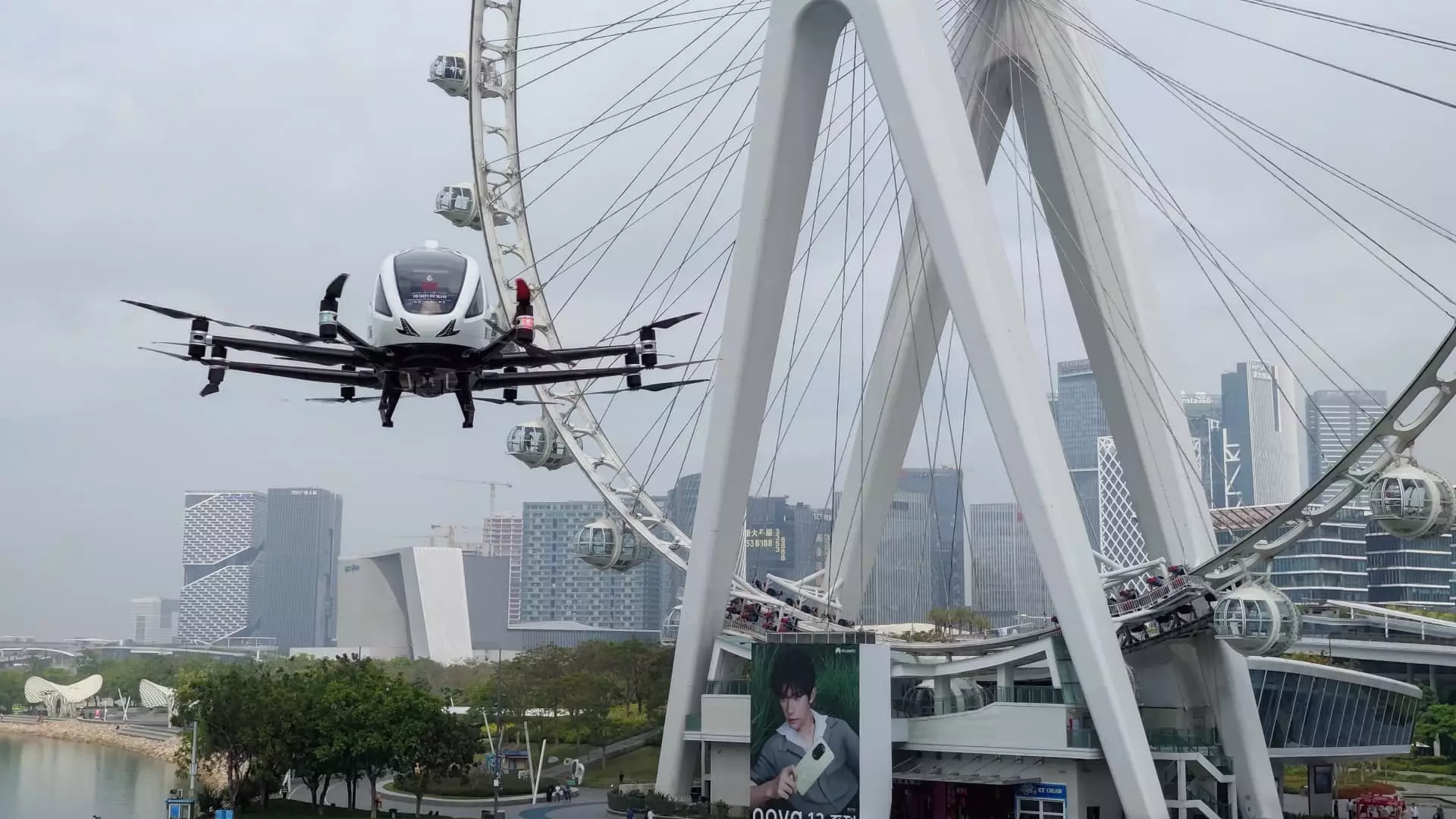Flying vehicles are no longer just the stuff of science fiction; they are inching closer to everyday life with companies like Ehang leading the charge. Recently certified by the Civil Aviation Administration of China, Ehang has positioned itself as the only player in the world currently authorized to operate passenger-carrying eVTOL (electric Vertical Take-Off and Landing) aircraft. While this milestone seems promising, it also raises critical questions about safety, regulation, and market dynamics—a combination that could either elevate Ehang to new heights or expose it to unanticipated pitfalls.
The Allure of eVTOL Technology
The appeal of eVTOL technology lies in its potential to radically alter urban mobility. Imagine a future where congested roads are largely a relic of the past, replaced by aerial public transport that whisks passengers above traffic grids with ease. Ehang’s two-passenger aircraft, priced between approximately $330,000 and $410,000, is designed for short trips, potentially revolutionizing tourism and local transportation. Analysts from Bank of America have heralded Ehang’s projected market dominance in China through 2027, largely due to rigorous aviation regulations acting as a barrier to entry for would-be competitors. But therein lies the rub: Sometimes, the allure of innovation can mask the duplicity of the challenges it brings.
Government Support vs. Market Hesitance
Bank of America’s analysts indicate that strong national policy support will fuel Ehang’s growth, predicting deliveries to reach 442 units this year and 813 next year. Yet, can we trust that government backing will be sufficient to ensure sustained success? The Chinese government sees the low-altitude economy as a critical pillar for economic growth, hastening Ehang’s path to market. However, this reliance on government support raises concerns about long-term viability—when state funding dwindles or policy priorities shift, will Ehang’s momentum collapse as swiftly as it was built?
The uneven commitment to eVTOL regulations internationally could also hamper Ehang’s expansion. The U.S. Federal Aviation Administration’s conservative stance, largely focusing on piloted flights, might create a protracted wait for companies like Joby Aviation and Archer Aviation. As Ehang rakes in consumer interest and market share, global competitors are also diligently working on compliance and safety standards that could promote broader market adoption in the near future. Ehang’s current “first mover” advantage may fuel shortsighted optimism, but a diverse array of competitors could quickly undermine its success.
Safety: The Long Shadow of Trust
The possibility of passenger injuries or accidents forms another significant risk factor for Ehang. In a sector that hinges upon public trust, each incident could prove catastrophic, triggering legal challenges and derailing the momentum of eVTOL adoption. Despite reassuring projections of high unit sales, potential setbacks from safety incidents could tarnish the company’s reputation—an outcome the Bank of America analysts caution against. Perceptions around reliability dictate consumer choice, especially in a nascent industry where every misstep is magnified.
Furthermore, a focus on rapid delivery over rigorous safety protocols could lead to dire consequences. The eVTOL market is not just about the thrill of airborne travel; it’s a domain where standards must be uncompromising. The balance between speed to market and adherence to safety regulations is delicate, and a failure to navigate this landscape could spell disaster, not only for Ehang but for the industry as a whole.
Competition: The Fast World of Innovation
While Ehang projects significant growth, its competitive landscape is rife with uncertainty. Rivals like Joby Aviation and Archer Aviation are making strides in pilot certifications and public relations. Joby has recently focused on the lucrative air taxi segment, positioning itself for high-profile projects like the Los Angeles 2028 Olympic Games. Analysts might currently rank Ehang as the frontrunner in the eVTOL race, but swift changes in competitor strategies could lead to an abrupt shift in market dynamics.
This ongoing innovation war means Ehang must not only maintain its lead but capitalize on it through exceptional marketing, partnerships, and diversified offerings. Just as the technology can be empowering, a failure to adapt could see consumers quickly shifting their focus to the next promising contender.
The Future: Promises and Perils Ahead
Ehang’s ambitious prospects hinge on its ability to deliver on its promises. The expectation of revenue growth exceeding 100% in upcoming years is impressive, yet requires an unwavering commitment to quality, safety, and consumer satisfaction. As we peer into the future, the duality of innovation becomes apparent: while the capabilities of eVTOL vehicles like Ehang’s hold tremendous potential, the specter of rapid failure looms large without careful navigation.
In a world where the air might become a new frontier for urban travel, every leap forward carries with it the weight of responsibility. The saga of Ehang will be one worth watching, even as it balances on the knife-edge of success and calamity.

